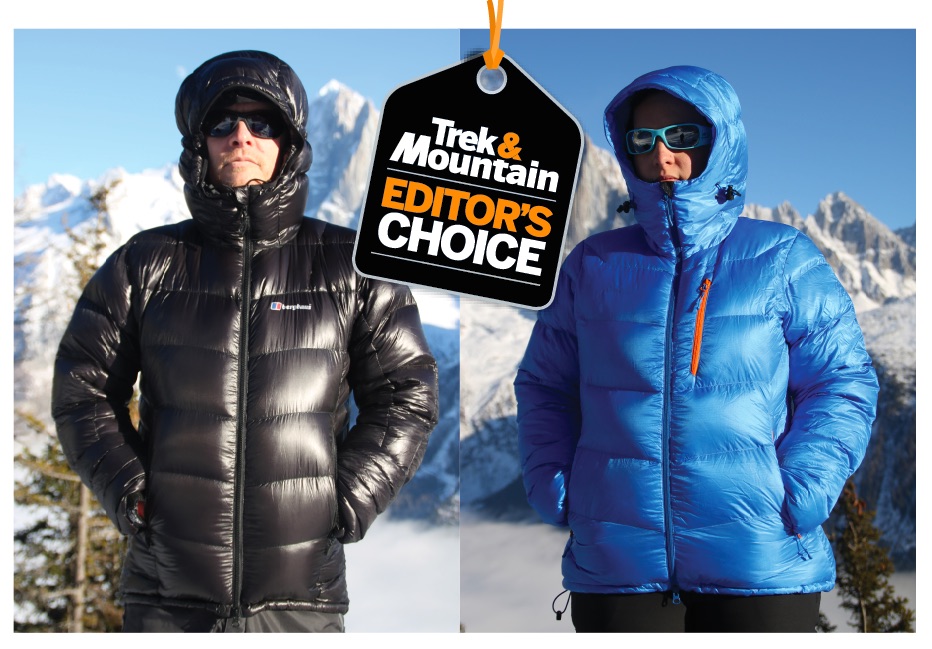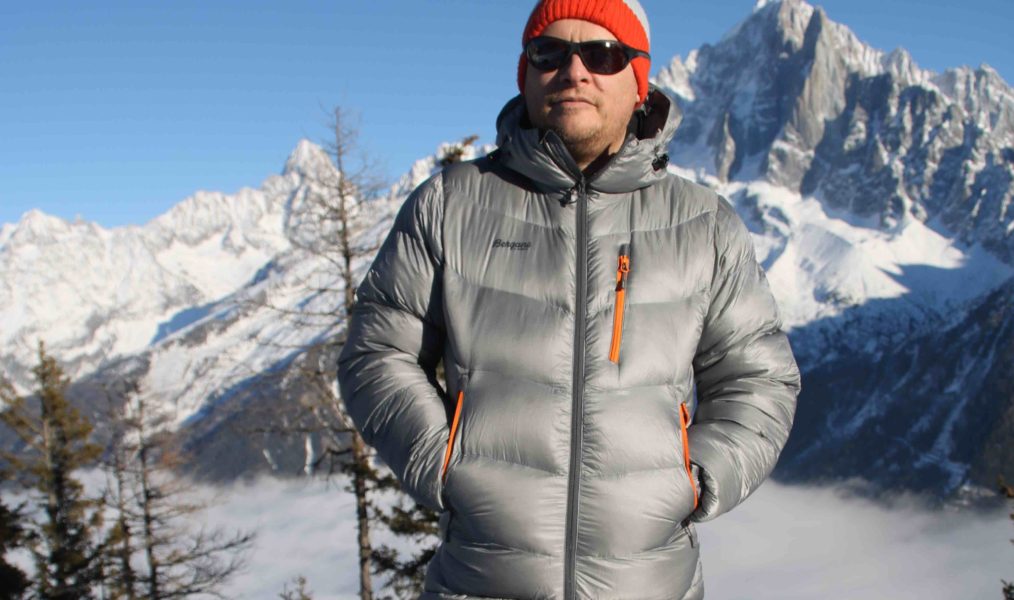We test out 14 midweight down jackets to find out which are best for all-round use, from hanging around camp to tackling summits on freezing days…
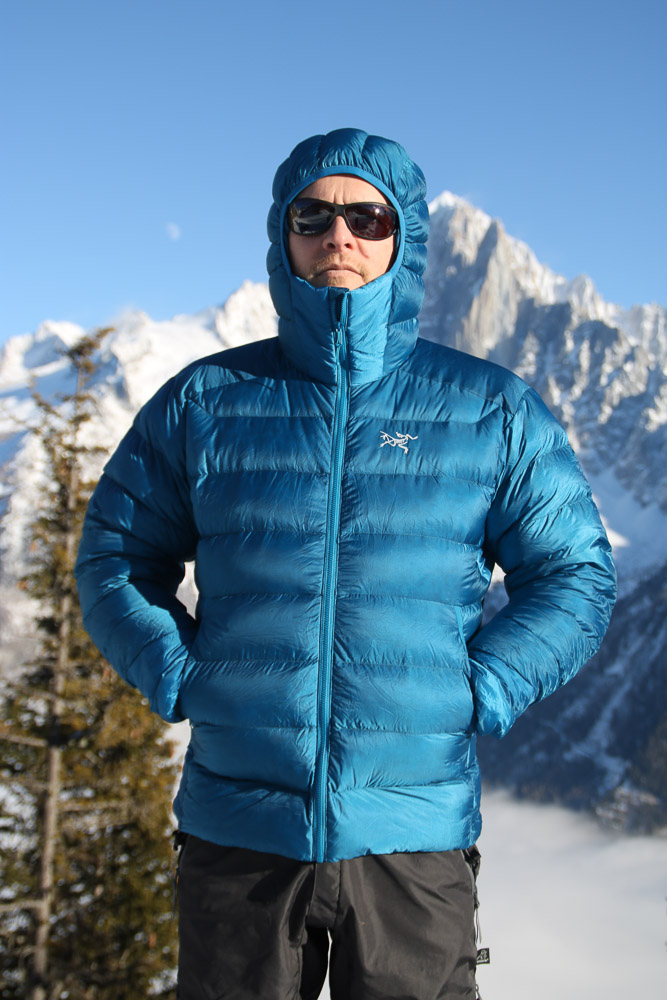
Arc’teryx Cerium SV Hoody (M)
Arc’teryx Cerium SV Hoody (M) £400
The Cerium SV Hoody, like one or two other jackets in this test, makes use of strategically-placed synthetic insulation – in this case, around the cuffs, hem and a strip in front of the mouth. Elsewhere, the jacket’s baffles are filled with 850+ European goose down, and although the fill weight wasn’t available, the jacket certainly feels warm and lofty. The fit and cut of the Cerium SV could be contentious for some –firstly it’s quite close-fitting, and secondly the cut of the jacket is quite high on the hips. We used the jacket with a baselayer and fleece, and this was fine, but you’d have trouble fitting any more layers than that underneath. If you do intend to use the jacket with more layers, then you will need to consider going up a size from normal. Likewise with the cut, the Medium we tested was great for climbing in as the jacket didn’t come down over the bum, but if you are looking more for protection than agility, then again you may have to go up a size. These issues aside, we enjoyed using the Cerium SV. It’s one of the warmer jackets in the test and also has a reasonably durable and water-resistant outer which makes you feel well protected inside. The hood is adjustable and warm, and the collar comes up nicely over the face. There’s just one, zipped pocket inside and, while we’d have liked to have had a stretchy ‘dump’ pocket as well, overall it’s a really nice jacket.
Verdict: Warm and well-made – be careful to check the size and fit before buying though
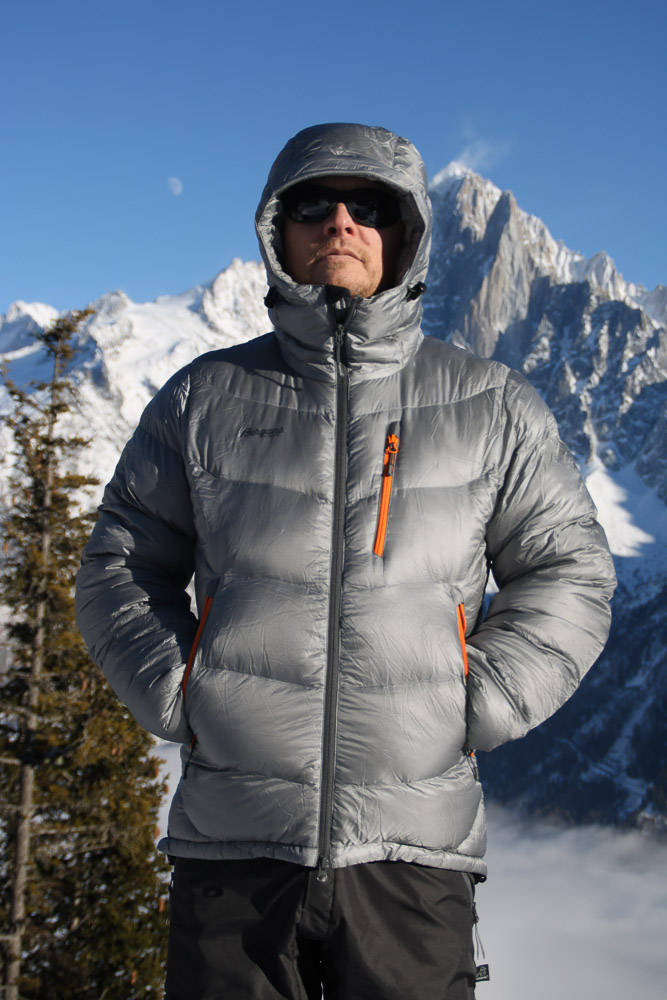
Bergans MemurUtind jacket (M)
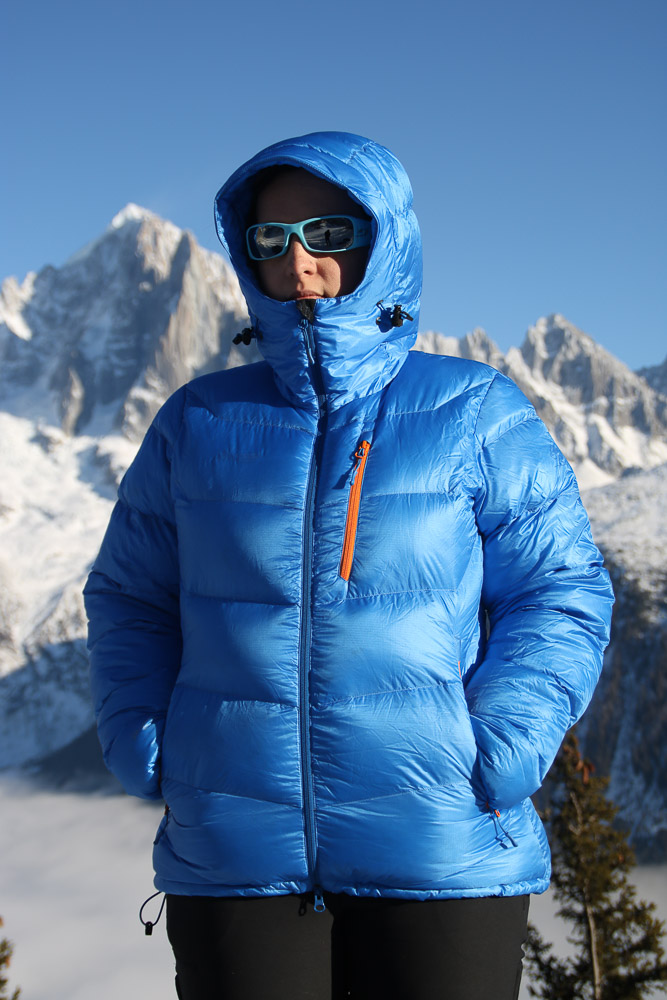
Bergans Memurutind jacket (W)
Bergans Memurutind jacket (M/W) £300
We tried both the men’s and women’s versions of the Bergans Memurutind, which was developed as a climbing and ski touring jacket for cold days and is both lightweight and packable. Of the women’s jackets, the Memurutind is our jacket of choice for more technical uses. While it contains less down and a lower fillpower than the Montane North Star Lite, it feels almost at par in terms of warmth – perhaps this is due to the additional down in the chest panel in the female version. Bergans seem to have taken additional layers into account when designing the Memurutind, and therefore we were able to use it as an over-layer without the need to size up. The articulated arms allowed us to move freely without any lifting. A dropped hem has one-handed adjusters on either side, while the two-way zipper is useful when wearing a harness. The elasticated cuffs are adjustable, using Velcro, and therefore could be worn over gloves/mitts. The hood on the Memurutind was the only hood in the female jackets which could be worn over a helmet comfortably, still allowing plenty of movement; it is fully insulated and has a wired peak for extra protection. There are four pockets – two side pockets, a chest pocket, and an internal pocket that doubles as an integrated stuff sac and is roomy enough to carry a water bottle.
Verdict: Great fit and features, and enough warmth for most uses
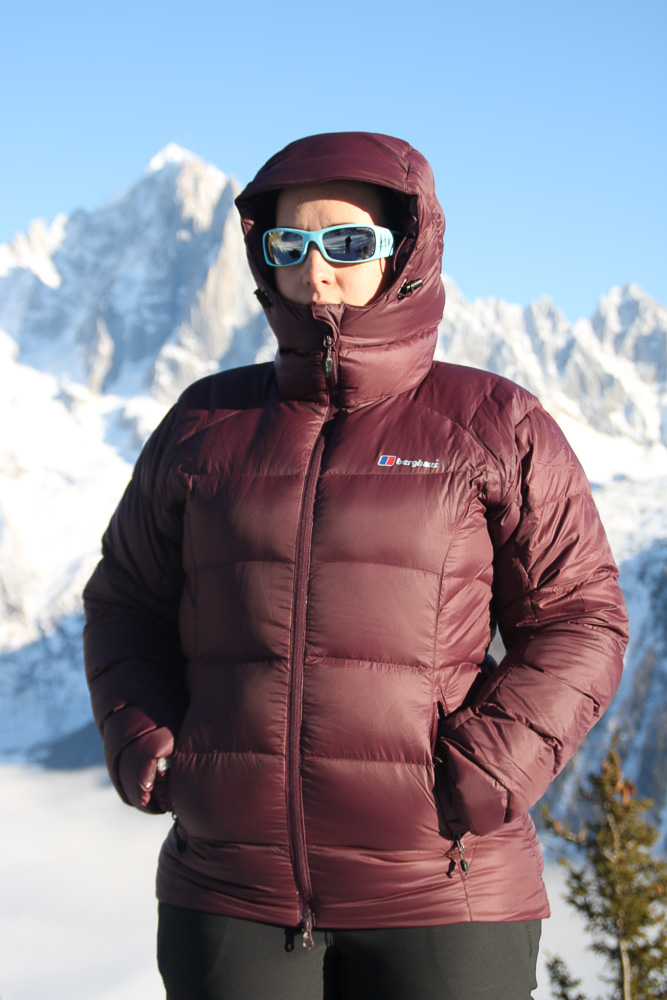
Berghaus Popena Hooded Jacket (W)
Berghaus Popena Hooded Jacket (W) £200
The Popena Hooded Jacket is both functional and inexpensive – it is the least expensive of the female specific jackets in this test, in fact. It has been well tailored for women and is very flattering, meaning that you won’t mind wearing it to the pub after a day in the mountains. Its features, such as the two-way zip, have been well- thought out for mountain use as well. The roominess of the cuffs meant that we could easily fit them over winter gloves/mitts, and Velcro adjusters allowed us to get a snug fit, with or without gloves, keeping the heat inside and the snow out. The one-handed hem adjustors were easy to use, also helping to get the right fit to retain warmth. There are three pockets: two hand-warmer pockets on either side and an internal pocket. The fixed hood is fully insulated and forms around the face well, providing plenty of warmth. The reinforced peak is not mouldable but keeps its shape well, and offers a lot of protection, while the rear and front adjustors let you customise the fit further. The hood could be used over a low profile helmet in a pinch, however, it did not allow for as much movement as we’d have liked. For this reason, and the fact that it’s slightly heavier, we’d likely use this jacket more for hiking or trekking tripes rather than mountaineering. The Popena fit fairly true to size, so if intending to wear many layers underneath, then you may want to consider sizing up.
Verdict: Not so suited to technical activities, but okay for general use
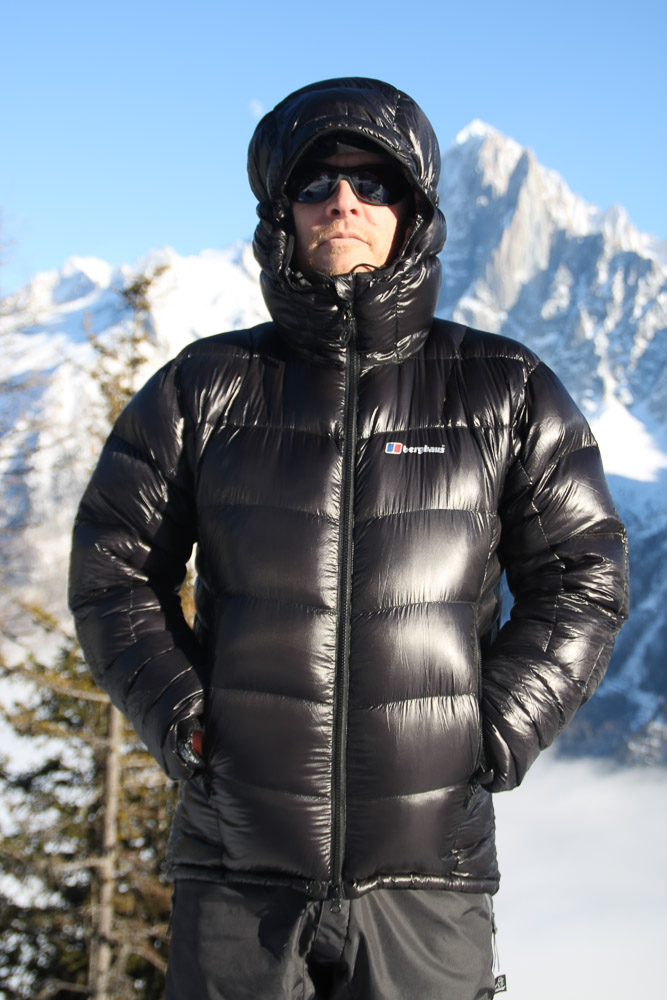
Berghaus Ramche Down 2.0 Jacket (M)
Berghaus Ramche Down 2.0 Jacket (M) £350
We tested the Ramche Down 2.0 Jacket a couple of issues ago and were impressed with it, to say the least. As with the first incarnation of the jacket, body-mapping has been used to make sure the down in the jacket is used in the right places to keep you as warm as possible with as little weight as possible. And offset baffles in the body mean that there are none of the cold spots that can occur with conventional stitch-through baffle jackets. There’s several key ideas on the new jacket that make it even warmer for its weight than the original Ramche and, importantly, kinder to the environment. The first innovation is that Berghaus have developed an aluminium mesh that is incorporated into the body of the jacket, which reflects body heat back into the jacket. This, according to the company, makes the jacket 10% warmer, which is quite a significant increase. Another development is that the hydrophobic down that fills the Ramche is now coated using a DWR (durable water repellent) developed by Nikwax, which is free of the harmful PFC chemicals used in most DWRs. The down is also RDS certified for ethical sourcing, and the good news is that despite these ‘green’ credentials the performance is not compromised, with the down used in the jacket able to repel water for up to 16 hours.
Verdict: A brilliant balance of warmth and low weight, the Ramche Down packs in the technology to great effect
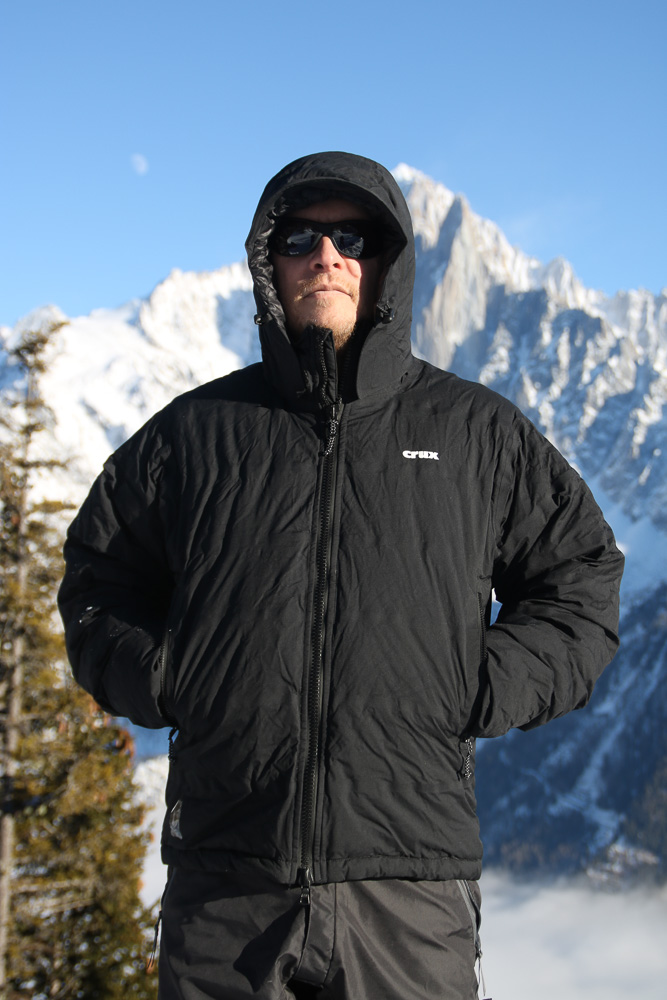
Crux Magma Jacket (M)
Crux Magma Jacket (M) £595
The Magma Jacket is the odd-one-out in this test as it is the only fully-waterproof jacket included. Whether this is important to you depends where you will be using the jacket, and while in most instances the water-resistant outers found on other models in this test will be perfectly satisfactory, there may be times when a fully waterproof outer is a definite advantage. The Magma Jacket uses 225g of 800 fillpower Polish goose down and, wrapped up in a 2-layer eVent shell (with no through-stitching), is pretty warm as a result. The cut, similar to the Arc’teryx Cerium SV, is quite high, and while good for being active, doesn’t give as much protection as a longer jacket. Likewise, the sizing means that if you want to wear more than a baselayer and one midlayer underneath, you’ll need to consider sizing up. The Magma is well equipped in terms of pockets, with two handwarmers on the outside and two dump pockets on the inside, and we liked the chunky water-resistant zips used, which are easy to handle. An oddity on this jacket is the removable hood. Using a zip and poppers at each side, the hood can be removed, leaving a high collar. While you could say this improves the versatility of the jacket, we would have rather have seen a fixed hood and a reduction in the price. Having said that, the Magma should be on your shortlist if you’re looking for a fully waterproof down jacket.
Verdict: A specialty jacket, but one that does what it does well
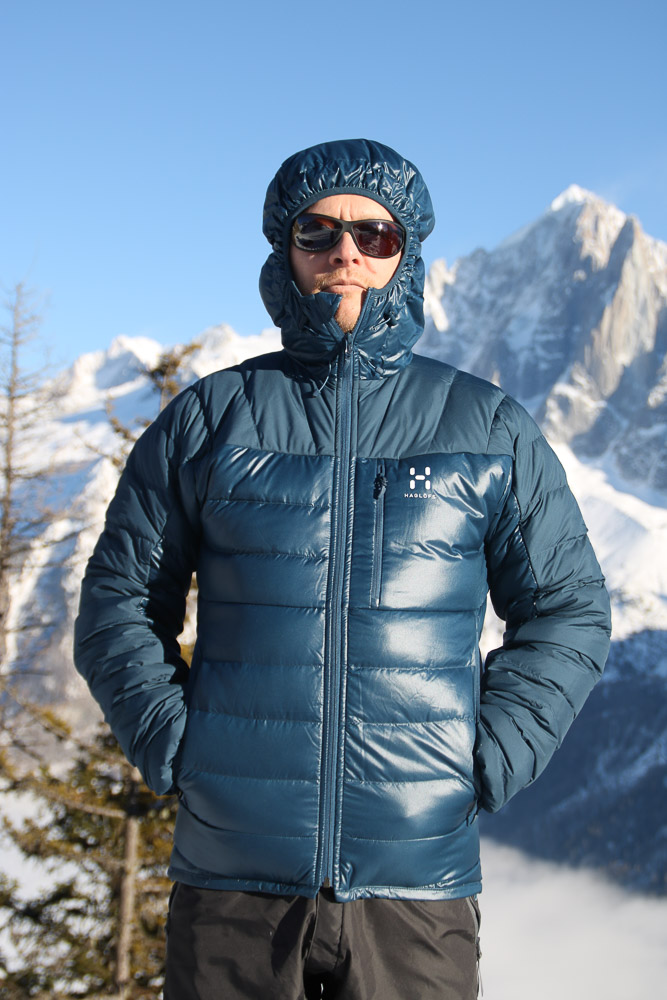
Haglöfs Bivvy Down hood (M)
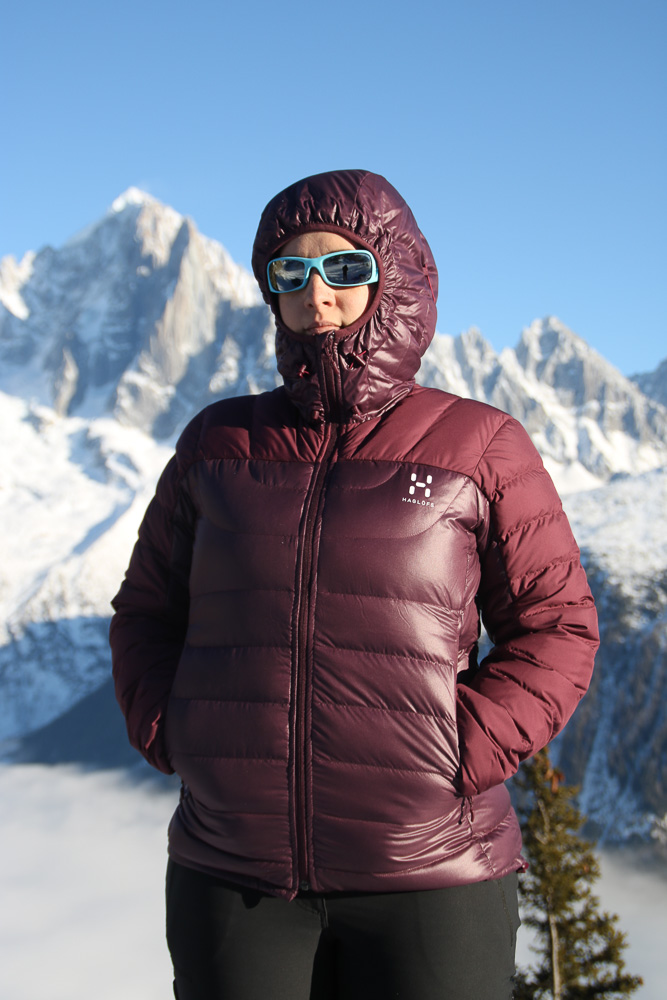
Haglöfs Bivvy Down hood (W)
Haglöfs Bivvy Down hood (M/W) £220
While not the warmest of the jackets on test, the Bivvy Down Hood jacket does seem to have one of the toughest builds. One of the first things you notice when looking at the jacket is the use of two different outer Pertex Classic Eco materials, almost giving it a two-toned appearance – a shiny 50D mini-ripstop weave fabric on the main body, and a matte taffeta fabric for the shoulder/sleeve reinforcements. The jacket is well-fitted and true to size. The hood is fully insulated and stretches around the face. It has plenty of adjustment; in the rear, there is a loop of cord that runs around the crown of the head. This is attached to the outside of the jacket with some webbing loops, which is unusual; however, it is quite efficient, and there are no apparent downsides. There are two adjustors in the front which are neatly tucked away with the ends coming out further down away from the face, to prevent them from hitting your face in windy conditions. The stretch cuffs prevent heat from escaping, but the lack of adjustment means that larger gloves/mitts need to be worn over the coat. The hem has two adjustors that are easy to use with one hand. There are three pockets – an internal pocket, and an outer pocket on either side – one of which doubles as an integrated stuff sack, complete with two webbing loops for hanging off a harness etc. When stuffing the jacket into the pocket, we found it to be fairly tight, and felt that a little more room would have been useful.
Verdict: Lighter than many in the test, this is a well-made and durable jacket
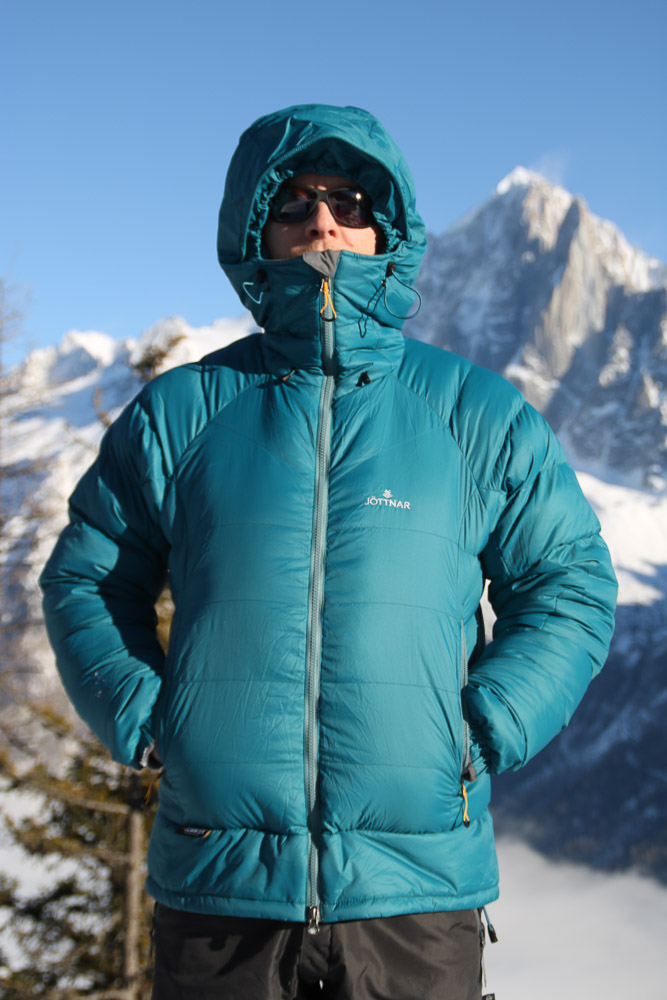
Jöttnar Fjörm (M)
Jöttnar Fjörm (M) £350
The Fjörm has been a favourite at T&M Towers since it was first released, and for winter 2016/17 there have been a number of improvements made on the original jacket. Weighing in at 648g, the Fjörm is at the top end of the jackets we tested, yet with its 237g of 800 fillpower down, it’s also one of the warmest. Make no mistake, this jacket was made to seal out the coldest weather, and this is reflected in many aspects of its design – from the boxwall baffle construction, to the oversized zip baffles and the superb hood which is one the few in the test able to accommodate a helmet. In terms of insulation, the Fjörm uses a water-resistant down (DownTek) that makes it ten times as resistant to water as standard down, and the damp weather credentials are further enhanced by the use of synthetic insulation at the cuffs, collar and hem. The hood on the Fjörm is one of the very best out there; it has fantastic adjustment via pull cords to tighten it around the face, and a volume adjustor at the back, plus has a flexible wired peak, and works with a helmet. The collar comes right up over the mouth and has a soft material on the inside, making a veritable haven from the cold. The pull cords are now on the outside which was one of our (small) criticisms of the original Fjörm. The fit, by the way, is quite generous, so several layers can be worn underneath.
Verdict: Superb jacket, ideal for general use as well as mountaineering
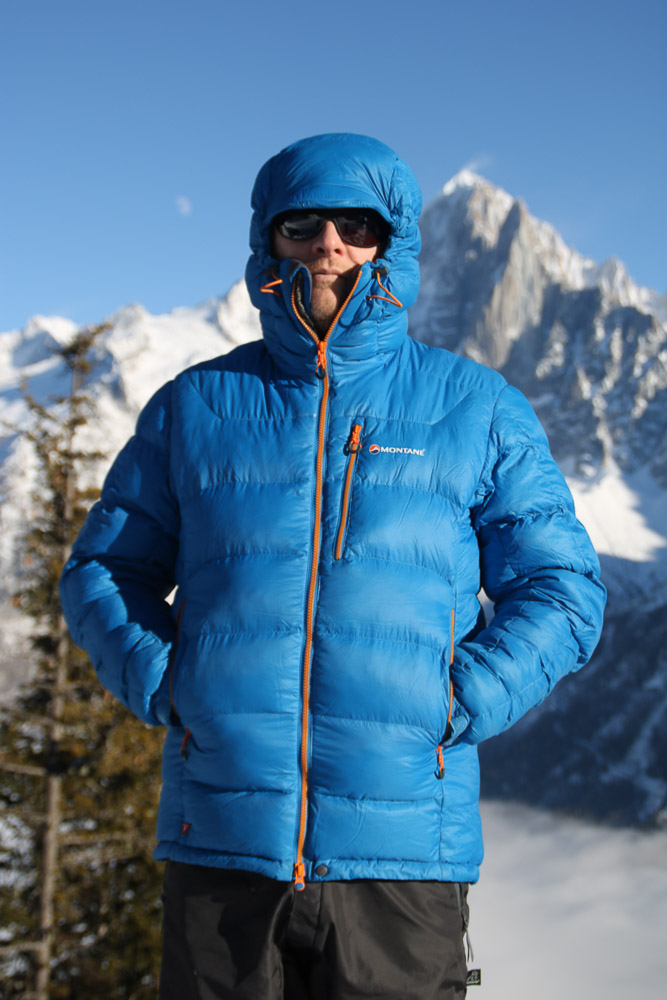
Montane Black Ice Jacket (M)
Montane Black Ice Jacket (M) £200
On paper, the feature list of the Black Ice is impressive, and this is certainly reinforced when looking at the jacket in the flesh. The jacket is filled with 250g of PrimaLoft Gold Insulation Down Blend fill, which consists of 70% goose down blended with 30% PrimaLoft synthetic fill fibres. The construction is of the boxwall type on the torso, to prevent any cold spots, while the stitch-through construction used in the arms means that these are less bulky which in turn allows more freedom of movement. Though there’s no mention of it in the spec, the fill seems thicker on the front of the jacket than the back, and this would make sense in terms of where you need the most warmth. The two-way main zip is a YKK Vislon and has an internal storm flap with an anti-snag seam along it. The two handwarmer pockets have a soft inner fabric and, on the inside, you find a stretchy ‘drinks’ pocket and a zipped security pocket. There’s also a zipped pocket on the chest. The hood is really well-specc’d, with a volume adjustor at the back and two cinch cords that pull the hood tight around the face. The peak is both stiffened (with a plastic insert) and wired, and the whole thing can be adjusted to fit precisely around your head/face for maximum protection. For staying comfy when the hatches are battened down, Montane have provided a generous area of soft material around the mouth to protect your chin.
Verdict: Well-featured down jacket at an attractive price
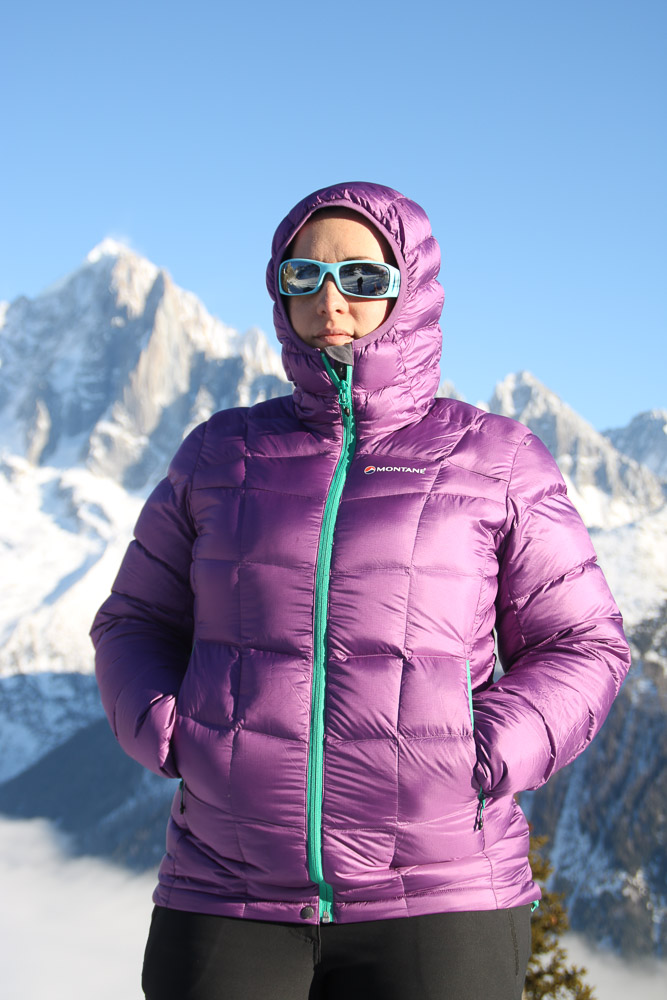
Montane North Star Lite Jacket (W)
Montane North Star Lite Jacket (W) £240
The North Star Lite Jacket has been designed for year-round alpine conditions and is the warmest of the women’s jackets in this test. Filled with 210g of water resistant 800+ fillpower HyperDRY down and a Pertex water resistant and windproof outer, it is super lightweight and packable, and comes complete with a roll-top dry bag. The fit is well-tailored for women; the hem is lower in the back and adjustable (one-handed adjustment), and does a good job of keeping the heat in. The articulated arms allow for plenty of movement – even with arms fully raised, we did not experience any lifting. The stretch cuffs prevent drafts getting inside, however they did not allow for enough room to wear over gloves/mitts, unless wearing only liners or thin gloves. The fully insulated hood stretches around the face and provides a fair amount of warmth, but although the pre-elastication in the rear of the hood does help with the fit somewhat, we would have preferred some form of adjustment as it did tend to sit a bit higher than we would have liked. There are two handwarmer pockets on either side that are a good size, and one internal pocket. We found the North Star Lite to fit true to size, so if intending to wear several layers underneath, it might be a good idea to size up. Our sample was in Dahlia – purple with bright green zips – which has somewhat of a retro feel, but those looking for a more subdued colour may prefer Black or Antarctic Blue.
Verdict: Warm and functional, but hood could do with more adjustment
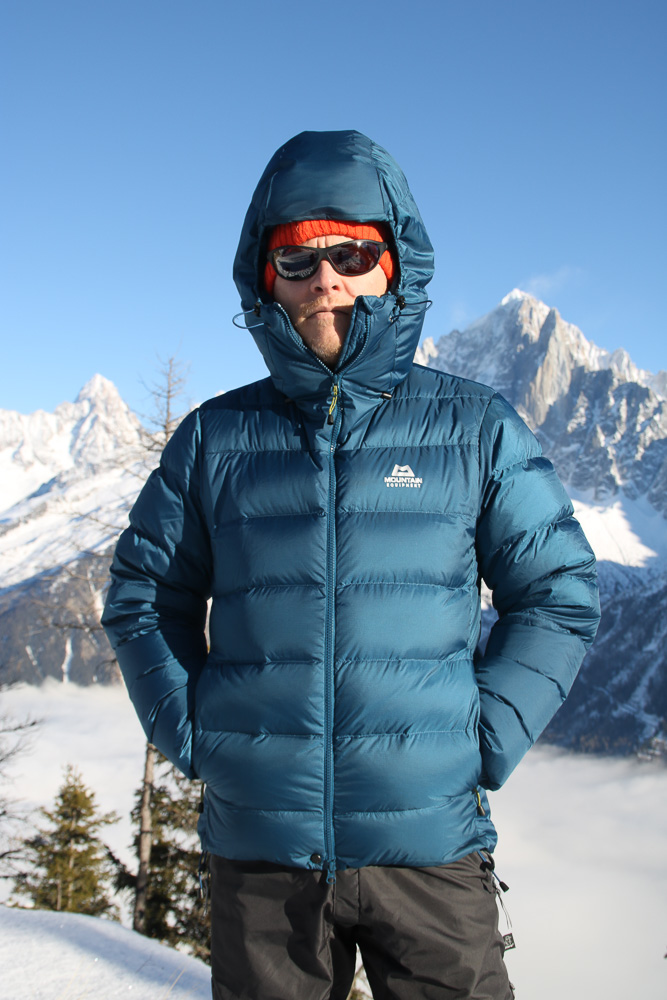
Mountain Equipment Vega (M)
Mountain Equipment Vega (M) £270
The Vega is a popular model in the Mountain Equipment range, and it’s easy to see why. The Drilite Loft outer shell feels substantial and gives you a breathable and windproof outer that is also highly water-resistant. Inside, the jacket’s baffles are filled with 235g (Large) of 800 fillpower goose down which is Down Codex certified and has a minimum 90% down/feather ratio (ME says it is more like 93%). The construction of the jacket is stitch-through and varying amounts of down are used in baffles, depending where the warmth is needed the most. In use we weren’t aware of as much body zoning taking place as in some other models in the test, rather a consistent spread of down around the jacket, but for static use (i.e. around camp) we found this an advantage, giving all-over warmth. The Vega’s hood, one of the best in our test, is well insulated and can fit a helmet underneath if required. It has side adjustors for getting a snug fit around the face, but we felt a volume adjustor at the back would have improved it further. The collar comes up over the lower face when done up, giving great protection in gnarly conditions. Overall the Vega was one of our favourite jackets in this test; it’s really warm, feels like it’ll give long service, and is an excellent choice for mountaineering as well as general use.
Verdict: One of our favourite jackets –warm, durable and a great price too
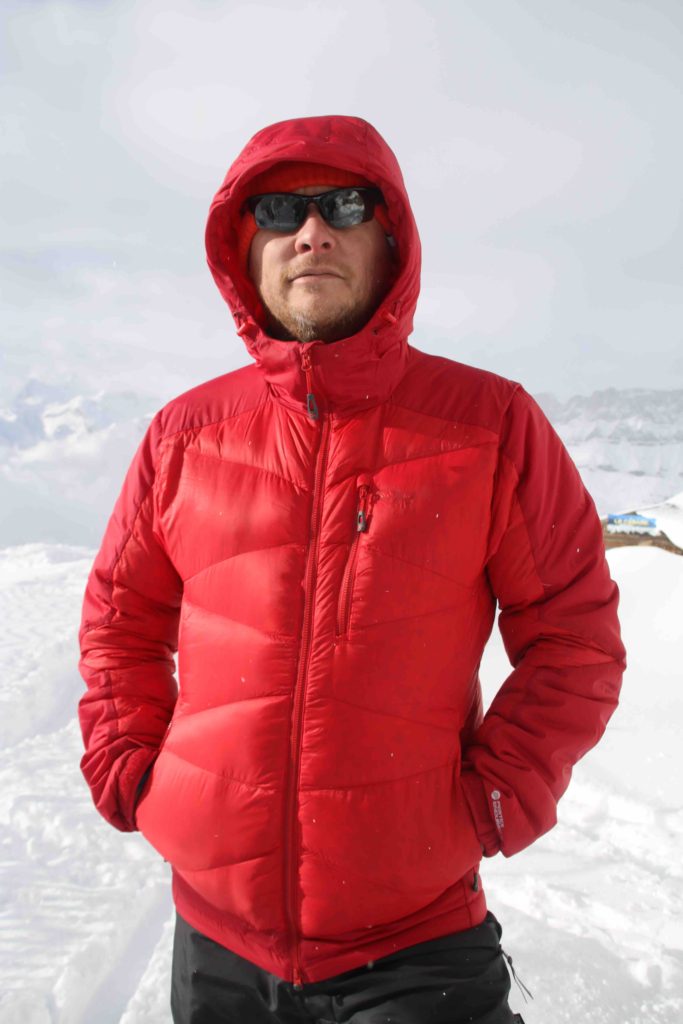
Outdoor Research Diode Jacket (M) £250
The Diode Jacket is another jacket that uses both down and synthetic insulation in the same garment. The main insulation is PrimaLoft Gold Insulation Down Blend (which is 70% down and 30% synthetic fibres) which is used in the body and underarms, while ‘pure’ PrimaLoft (synthetic) is used on the outer arms, hood, shoulders and hem. As a result, despite its 521g overall weight it is somewhat less bulky – and less warm – than many of the jackets in this test. The fit is pretty trim too, which makes it great for ice climbing for example, but if you intend to use it more as a belay-style jacket, you will want to consider going up a size in order to be able to throw it over other layers. The diagonally-orientated baffles look appealing though we’re not sure if they have an practical purpose or advantage. The jacket has plenty of pockets, including one on the chest, two handwarmers, one internal zipped pocket and two stretchy mesh dump pockets. The hood is also well-equipped, with two cord pulls to adjust the fit around the face and a volume adjustor at the back, plus a wired peak – it is also able to accommodate a helmet. This last point is pertinent, as we feel the Diode is perfectly suited to climbing in cold weather, whether that’s on ice, mixed or even rock. For less active use, one of the warmer jackets in this test would be more suitable.
Verdict: Well-suited to active use in cold conditions
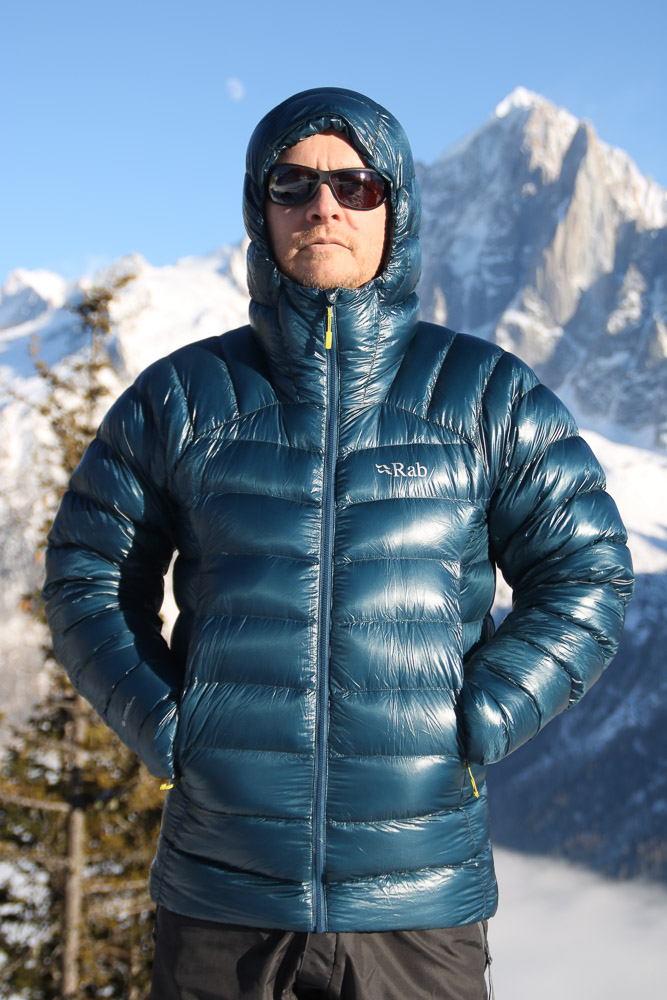
Rab Zero G Jacket (M)
Rab Zero G Jacket (M) £350
The Zero G Jacket is another super light and warm down jacket that we reviewed recently and were particularly impressed with. It is Rab’s first ever 1000 fillpower jacket, and this makes it deceptively warm. It almost feels like a micro-baffle down jacket in terms of bulkiness but is way warmer than this type of jacket. Not only is it very light (just 288g for the Medium sample we were sent), it is extremely compressible too, packing down to about the size of two Coke cans placed side-by-side, which is very small. The inner and outer of the Zero G use a super-light, 7-denier Pertex Quantum GL fabric, and this is soft to the touch and quite shiny. This is quite similar to that used on the Berghaus Ramche and, while it is a major factor in the jacket’s impressively low weight, we do have some reservations about the long-term durability of the fabric. The construction is of the stitch-through type, and there doesn’t appear to be a huge amount of zoning going on, just a constant thickness of insulation all over the jacket. However, since the jacket is not bulky, we didn’t find this an impedement to movement when active. There are two handwarmer pockets, virtually hidden when not open by the use of YKK Conceal zips, and there is a semi-elasticated hem and elasticated cuff. The hood has a fabric volume adjustor at the back and could fit some helmets at a push, but we found it actually worked quite well inside a helmet.
Verdict: Super lightweight jacket that’ll appeal to alpinists and backpackers
SUMMARY
All the jackets in this test offered slightly different combinations of warmth, weight and features, and this shows what a great choice there is for anyone shopping for down jackets at the moment – there’s no reason why you can’t get exactly what you are looking for. As for our favourites, well the Berghaus Ramche Down 2.0 Jacket just got the nod ahead of the excellent Jöttnar Fjörm for the men’s Editor’s Choice award, the incredibly low weight and packability for its weight impressing the test team, as well as its mountaineering-focused features. Out of the four women’s models we tested, the Bergans Memurutind Down Jacket was the stand-out jacket, its features giving you all the functionality you need, and its loose fit allowing multiple layers to be worn underneath if required.
